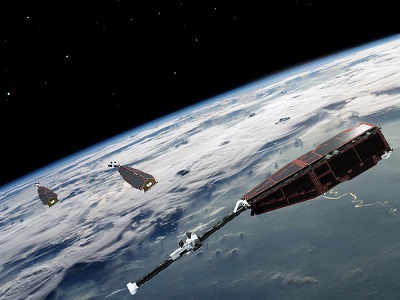- Activities
- ULF waves in the topside ionos...
ULF waves in the topside ionosphere as observed by Swarm
Overview
The “ULF waves in the topside ionosphere (Swarm-ULF)” was a project as a part of Swarm DISC 5 activities.
Ultra low frequency (ULF) waves (or geomagnetic pulsations when observed on the ground) are ubiquitous in space plasmas. Their periods range from seconds to minutes. The morphological classification of geomagnetic pulsations was introduced in the 1960s dividing them into two main groups, the more regular, sinusoidal continuous pulsations (Pc), and the impulsive, more irregular (Pi) pulsations. These groups are further divided according to the wave periods as follows:
| Type (regular) | Period | Type (irregular) | Period |
| Pc1 | 0.2 – 5 s | Pi1 | 1 – 40 s |
| Pc2 | 5 – 10 s | Pi2 | 40 – 150 s |
| Pc3 | 10 – 45 s | ||
| Pc4 | 45 – 150 s | ||
| Pc5 | 150 – 600 s |
Not all types of ULF waves can be detected clearly by a low-Earth orbiting (LEO) satellite. The detectability depends first on the wave period, the along-track phase variation which may make the detection impossible due the fast orbital speed of LEO satellites (~7.5 km/s). Pc1 waves are the only transverse ULF waves that can be detected safely by polar LEO satellites due to their higher frequency (shorter wave period). Since compressional Pc2-3 waves propagate from the subsolar magnetopause toward the Earth, their phase fronts are close to parallel to the ionosphere, and the resulting Doppler shift is small. Also, their frequency allows for their clear observations. Pi2 waves are believed to be produced by compressional mode cavity resonances standing between the ionosphere and a higher altitude boundary and hence, resulting in phase fronts parallel to the ionosphere. Hence, Pi2s can also be detected with high confidence at LEO. Finally, compressional Pc1 waves, due to their short period, can be observed regardless of the direction of the propagation.
In the frame of the Swarm-ULF project, the L2 product ULF characterising lower-band ULF waves, and the PC1 product characterising Pc1 waves have been developed. The ULF product provides a detailed characterisation of compressional Pc2, Pc3, Pc4, as well as Pi2 waves.
Transverse Pc1 pulsations are electromagnetic ion cyclotron (EMIC) waves of magnetospheric origin. In the ionosphere, the initially transverse EMIC waves can couple to the compressional mode and propagate long distances in the ionospheric waveguide. The Swarm PC1 L2 product is developed for characterising both Pc1 modes.
ULF was a project carried out at the HUN-REN Institute of Earth Physics and Space Science, Sopron and Tihany, Hungary.
Documentation
Download project documentation:
Project duration: November 2022 – September 2024.
